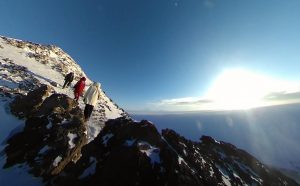4-H invites students to tag along on Antarctic expedition
By Dr. Lisa Phelps, Program Administrator with University of Maine Cooperative Extension

A unique program in Maine is giving teachers around the country the opportunity to let their students tag along with a researcher in the field. The program shows K-12 students the real-life scientific journeys that a STEM-rich (science, technology, engineering, and mathematics) education can provide.
Follow a Researcher® is an innovative University of Maine (UMaine) 4-H program that uses technology and social media to connect K-12 classrooms with graduate students conducting field research in remote locations. One student, Lynn Kaluzienski, is using physics and geology to study the McMurdo Shear Zone in Antarctica.
Lynn and a team of scientists, engineers, and mountaineers are conducting scientific tests to determine how stable the Ross Ice Shelf will be in the future and how Antarctic sea ice melt may affect sea level rise. Follow a Researcher® is partially funded by USDA’s National Institute of Food and Agriculture (NIFA) through UMaine Cooperative Extension.
Lynn’s project is the third Follow the Researcher® expedition. The first expedition went to Peru in March and April 2015 to search for evidence of historic climate change events in glacial snow and ice. The second expedition went to the Falkland Islands in January and February 2016. More than 1,800 youth and 88 adults followed along to help unravel the mystery of how and when the warrah, an extinct species of fox, reached the Falklands and what caused its extinction. More than 2500 youth and 200 adults from 12 states are signed up to follow Lynn’s expedition.
“We give students a glimpse into a scientist’s world by providing live expedition updates via weekly twitter chats. Their questions may be generated by a video or anything else students want to know about the expedition,” said Gregory Kranich, UMaine Cooperative Extension 4-H Science Youth Development Professional. “We also provide information on how educators may use this information in their classrooms, including demonstrations and experiential learning activities.”
The K-12 students who tag along virtually are not the only ones who learn from the experience, said Laura Wilson, UMaine Cooperative Extension 4-H Science Youth Development Professional. The researcher also learns from their interactions with the youth.
“The researchers are excited to share their experiences,” she said. “They are eager to deliver the message that being a scientist opens up amazing opportunities.”
One of the special aspects of Follow a Researcher® is that the emphasis is on who scientists are and what they do. Rather than being a content-driven experience, youth participants become agents of their own learning and are able to decide what information is relevant to them. We set the stage, but youth drive the Q&A sessions, pushing their learning beyond the scope we had imagined.
For more information about Follow a Researcher®, call 800.287.0274 (in Maine) or email UMaineFAR@Maine.edu.
